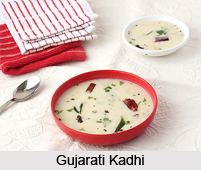 Gujarati Kadhi is a yogurt based sweet and spicy curry that is simple. The Kadhi goes well with any vegetable. It is also traditionally served along with Khichdi together known as "Khichdi Kadhi". It is usually eaten along with plain rice, jeera rice or roti and chapati. Gujarati kadhi differs from other North Indian variations like Punjabi kadhi, Maharashtrian Kadhi, Rajasthani kadhi etc. It is sweeter in taste and little thinner also.
Gujarati Kadhi is a yogurt based sweet and spicy curry that is simple. The Kadhi goes well with any vegetable. It is also traditionally served along with Khichdi together known as "Khichdi Kadhi". It is usually eaten along with plain rice, jeera rice or roti and chapati. Gujarati kadhi differs from other North Indian variations like Punjabi kadhi, Maharashtrian Kadhi, Rajasthani kadhi etc. It is sweeter in taste and little thinner also.
Ingredients:
•Curd - 2 cups
•Gram flour - 1/2 cup
•Oil - 3 tbsp
•Cumin Seed - 1 /2 tsp
•Mustard Seeds - 1 /2 tsp
•Fenugreek Seeds - 1 /2 tsp
•Curry Leaves - 8
•Asafoetida a pinch.
•Turmeric Powder - 1/4 tsp
•Green Chilli - 2, finely chopped
•Ginger - 1 inch
•Salt to taste
•Jaggery or sugar - 1 tsp
•Dry Red Chilli - 2
•Red Chilli Powder - 1/4 tsp
•Coriander Leaves - 2 tbsp, finely chopped
Method:
1. Sieve the flour and add curd into it.
2. Whisk the batter well by adding 1 liter water into it.
3. Heat oil in a pan and temper the cumin seeds, mustard seeds, fenugreek seeds in it on a low flame.
4. Once the cumin seeds and fenugreek are roasted well add asafoetida, turmeric powder, curry leaves, green chilli and ginger paste to it. Mix the masala well and roast with the spoon.
5. Pour the kadhi batter into the roasted masala and let it boil on a high flame. Stir the kadhi continuously while cooking it.
6. Once the kadhi starts to boil stop stirring it and add salt, coriander leaves, red chilli and sugar to it. Cook the kadhi on low flame for another 15 minutes.
7. Gujarati Kadhi is ready. Transfer it in a serving dish.
8. Now take a small pan and heat oil in it.
9. Temper the cumin seeds into it and turn off the flame followed by adding red chilli and red chilli powder in it.
10. Pour the tampering into the kadhi along with coriander leaves.
11. Serve the hot Gujarati Kadhi with naan, chapati or rice.
Tips for Gujarati Kadhi
Remember never to boil the kadhi on a high flame as it tends to curdle. Use sour curd or buttermilk for sourness which gives the authentic taste to Gujarati kadhi. Instead of adding sugar to Gujarati kadhi add some jaggery. It is a healthier option and it balances the sourness of curd. Kadhi is excellent home remedy for cough and cold. Make sure to add a little garlic if one is making this kadhi to reduce cold or cough.




















